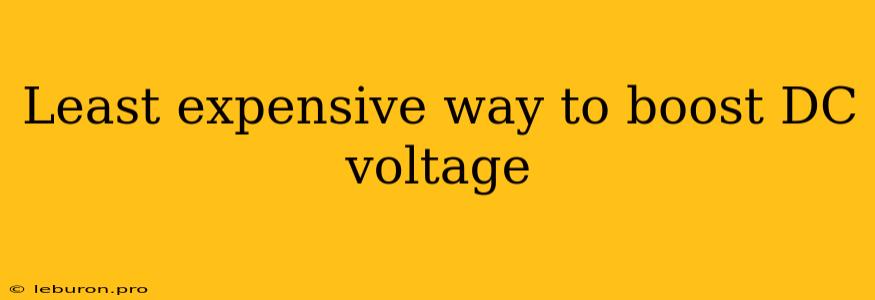Boosting DC voltage is a common requirement in various electronic circuits and applications. From powering LED strips to charging batteries, increasing the voltage level can be crucial. However, the cost of voltage boosting solutions can vary significantly. This article explores the least expensive ways to boost DC voltage, focusing on practical and cost-effective methods for hobbyists, makers, and anyone seeking budget-friendly options.
Understanding Voltage Boosting
Voltage boosting is the process of increasing the voltage of a DC power source. This is typically achieved by converting direct current (DC) into alternating current (AC) and then stepping it up using a transformer. Finally, the AC voltage is rectified back into DC at the desired higher voltage.
The Least Expensive Ways to Boost DC Voltage
Here's a breakdown of the least expensive ways to boost DC voltage, categorized based on their simplicity, cost-effectiveness, and application suitability:
1. DC-DC Boost Converters
DC-DC boost converters are dedicated integrated circuits (ICs) specifically designed for voltage boosting applications. These ICs offer a simple and efficient way to increase DC voltage. They typically come in small packages and require minimal external components.
Advantages:
- Low cost: DC-DC boost converters are often the most affordable option, particularly for small-scale projects.
- Easy to use: They are typically straightforward to integrate into circuits, requiring minimal external components and knowledge.
- High efficiency: Modern boost converters can achieve high efficiency, minimizing power loss.
Disadvantages:
- Limited output power: DC-DC boost converters have limitations in terms of the maximum output power they can handle.
- Current limitations: The output current is often limited, making them unsuitable for high-current applications.
Popular Choices:
- XL4016: This is a widely available and versatile boost converter IC.
- MC34063: This IC is another popular choice for boosting DC voltage, offering various output voltage options.
2. Step-Up Transformers
While not as common as DC-DC boost converters, step-up transformers can also be used for voltage boosting. These transformers use electromagnetic induction to increase the voltage.
Advantages:
- Can handle higher power: Step-up transformers can handle higher output power compared to DC-DC boost converters.
- Can provide higher voltage: They are suitable for achieving higher voltage levels than most DC-DC boost converters.
Disadvantages:
- Larger size and weight: Transformers are generally larger and heavier than IC-based solutions.
- Lower efficiency: Step-up transformers tend to have lower efficiency compared to DC-DC boost converters, resulting in more power loss.
- Limited frequency response: They are not suitable for high-frequency applications.
3. Voltage Multiplier Circuits
Voltage multiplier circuits use a series of capacitors and diodes to multiply the input voltage. This method is particularly suitable for low-power applications and generating high voltage levels from a low-voltage source.
Advantages:
- Simple to build: These circuits are relatively simple to construct using basic components.
- Low cost: Components like capacitors and diodes are generally inexpensive.
- Can achieve high voltage: Voltage multipliers can generate high output voltages, making them useful for specific applications.
Disadvantages:
- Limited power output: Voltage multipliers are not suitable for high-power applications.
- Low efficiency: They tend to have lower efficiency due to capacitor losses.
- Higher ripple: Output voltage often has higher ripple compared to other boosting methods.
4. Cockcroft-Walton Multiplier
The Cockcroft-Walton multiplier is a specialized voltage multiplier circuit that can achieve very high voltage levels. It uses a cascade of capacitors and diodes to effectively multiply the input voltage.
Advantages:
- Can generate extremely high voltage: This circuit is capable of generating very high voltage levels, exceeding the capabilities of other methods.
- Suitable for high-voltage applications: This makes it ideal for applications like electrostatic precipitators and particle accelerators.
Disadvantages:
- Complex design: The Cockcroft-Walton multiplier is a more complex circuit requiring more components.
- Lower efficiency: Efficiency is lower due to multiple capacitor losses.
- Limited power output: Output power is limited due to inherent losses.
Choosing the Right Method
Selecting the least expensive way to boost DC voltage depends on factors like the required output voltage, power level, application, and efficiency requirements.
For low-power applications requiring relatively low voltage boosts, DC-DC boost converters are often the most cost-effective and readily available option. They are easy to integrate, offer high efficiency, and come in compact packages.
If higher power is required or if the voltage boost needs to be significant, step-up transformers can be considered. However, they are larger and heavier, less efficient, and have limitations in frequency response.
For low-power applications needing extremely high voltage boosts, voltage multiplier circuits or the Cockcroft-Walton multiplier may be suitable. However, their efficiency and power output are limited.
Conclusion
Boosting DC voltage can be achieved in various ways, each with its advantages and disadvantages. The least expensive way to boost DC voltage typically involves DC-DC boost converters, which are readily available and offer high efficiency. Other methods like step-up transformers, voltage multiplier circuits, and the Cockcroft-Walton multiplier can be considered based on specific application requirements and limitations. Ultimately, careful consideration of the project's needs will guide the selection of the most cost-effective and suitable solution.
